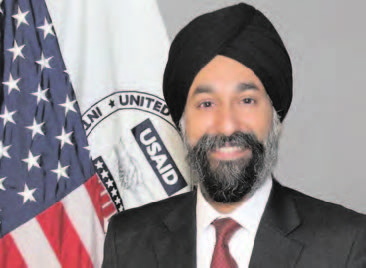SAN FRANCISCO (TIP): The India Diaspora Investment Initiative, a unique program President Barack Obama unveiled during his visit to India for the Republic Day celebrations, is seeking investment from Indian American and other investors to support sustainable development in India.
In an interview to the media here Manpreet Singh Anand, deputy assistant administrator in the Asia bureau of the U.S. Agency for International Development, said that it is the first time an initiative earmarked for a specific diaspora community in the U.S. has been launched by USAID.
If it is successful, he added, it could be a model for the agency in other countries.
“It is a new model for development,” Anand said. “It is a more efficient use of resources to leverage innovation through the private sector.” USAID staff has been working on the initiative for about a year, he added.
India was not a random choice for the initiative.
USAID said in a fact sheet that there are three factors why India was selected: “An increased desire on the part of Indian Americans to make a development impact in their home country; a strengthened diaspora connection to India after the election of Prime Minister Narendra Modi; and a strong demand from Indian social businesses seeking debt capital to scale up their programs targeting ‘Base of the Pyramid’ populations.”
USAID, working with a partner – Bethesda, Md.-based Calvert Foundation, a nonprofit with experience in offering “Community Investment Notes” for sustainable development – plans to mobilize at least $50 million in debt financing from private sector financial sector institutions in India and abroad over the next 18 months.
USAID will provide “up to a 50% credit guarantee” to three non-bank finance companies (Caspian Impact Advisors, Intellegrow and Gramen Impact India) and two Indian banks (YES Bank and Ratanakar Bank), who make the loans to small- and medium-sized enterprises in India.
Anand pointed out that without USAID’s credit guarantee, the barriers for Indian SMEs to get the loans “would be almost impossible to overcome.” “We want the Indian diaspora to become engaged and stay engaged,” he added.
It works like this: Investors – Indian Americans or those wanting to support sustainable development in India – purchase a Calvert Foundation Investment Note. Investors can receive fixed interest payments every six months and select investment tenors from one, three, five, seven and even 10 years.
The notes will be available later this year, Anand said. USAID is negotiating on terms of the loan credit guarantees with all five partners.
Calvert will make the loans to the Indian NBFCs and banks, which invest in social projects in healthcare, small businesses, education, agriculture, renewable energy, and other priority areas for India. USAID provides its 50% loan guarantee.
“Our new Indian Diaspora Investment Initiative will allow folks back home to generate a new stream of financing for Indian businesses that are investing in non-traditional, and too often overlooked, markets – from providing healthcare to rural communities, to improving water and sanitation, to opening up those new bank accounts,” Obama told the U.S.-India Business Summit in New Delhi Jan. 26.
USAID Administrator Rajiv Shah, who in February left the agency, said in India in January, “We’ll match the diaspora community’s immense passion and resources to the small businesses that form the backbone of India’s economy.”
“By creating a transparent investment vehicle, any investor can contribute to sustainable, social businesses that create jobs and train a new generation of local entrepreneurs.”
USAID’s annual funding to India -negotiated between the Obama administration and Congress – is currently “just short of $100 million a year,” Anand sadi.
It is the Indian American’s second stint at the agency. Previously, he was a presidential management fellow in the Office of the Global Development Alliance.
He also worked as a senior policy advisor on geopolitical and socioeconomic issues at Chevron Corp., was a senior policy advisor for South and Central Asia issues on the U.S. House Committee on Foreign Affairs, and served in the Office of the U.S. Trade Representative.
Married to a physician, Anand has an MBA and an M.A. in international studies from U.C.-Berkeley and a B.S. in electrical engineering from the University of Texas at Austin.
Another significant program announced by USAID during Obama’s visit was support of Modi’s Jan Dhan initiative to prioritize financial inclusion for all Indian citizens.
USAID is partnering with over 20 U.S., Indian and international private sector organizations and the World Economic Forum to extend the ability for Indian consumers and businesses to participate in the formal economy.
“More than 110 million people have signed up in India (under Jan Dhan) for bank accounts in the last few months,” said Anand, who accompanied Shah and Obama on the India trip in January. “It will really empower consumers in India when they can use cards instead of cash.”
USAID said that currently only six percent of retail enterprises in India can accept digital payments.
One particular area of focus for USAID in India is reducing child mortality rates. “India constitutes 24 percent of the preventable under-five deaths in the world,” Anand said. “There’s a lot we can and are doing (to reduce child mortality rates) in India.”
Last year USAID formed the U.S. Global Development Lab within the agency to leverage science and technology advancements for public-private partnerships around the world, Anand said.
Experts from Google and other technology companies are forming a think-tank within the agency to work with NGOs to solve some of the most pressing social problems around the world.
For more information on the Diaspora Investment Note, visit:
http://www.calvertfoundation.org/india.
